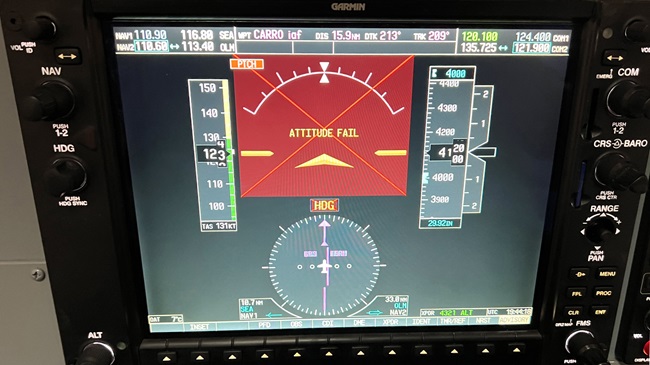Practical instrument: Welcome to the real world
Bringing your instrument training to life

For me the first solo instrument flight was a bigger accomplishment than my first solo flight. Trusting the airplane, the ground-based navigation system, and my training felt like a giant leap.
For me and I’m sure many others, the euphoria of passing a checkride often turns to nervousness. It can feel like you’ve gotten away with something and aren’t truly prepared to take on the challenge of flying in the real world. Looking back on that first solo instrument flight I realized that success after the checkride comes down to trusting that you are ready, and having a plan to get better. With a plan to increase proficiency that begins soon after the checkride, you can continue to build on your training, and more importantly, build confidence in the process.
The biggest mistake people make when they earn an instrument rating is immediately letting the skills become stale. It’s understandable. The training is difficult, and you just want to look outside the windscreen after months of feeling like a caged mouse under foggles. You must force yourself to continue growing as an instrument pilot because unlike after the private pilot certificate, that growth doesn’t happen automatically when you get in the airplane. You need to plan for it. A three-tiered approach can help.
Start slow
The basis of everything you need to do to be a good instrument pilot is broken down into three skills—the ability to effectively work in the IFR system, basic attitude instrument flying, and weather interpretation.
Athletes drill basic skills so they become second-nature when they move to more advanced techniques and gameplay. You can do the same. As soon as you get your rating, plan some trips. They don’t have to be long. In fact, the best mix includes some short 50-mile jaunts; a few longer, 100- to 200-mile flights; and one or two that take you somewhere a bit longer. Here’s the kicker. File and execute an IFR flight plan for each, but plan for VFR days. Reverting back to your previous comfort level with the weather will enable you to focus exclusively on the IFR procedures. Most students do a lot of approaches at their home airport as they train for the rating, but your goal is to get out there and see the world a bit. Fly to airports you’ve never been to and ask to do a practice approach once you get there. There’s no need for a safety pilot or view-limiting device. Your only goal is to work on procedures. Think back to your private pilot training and you can see why this works. Your first post-checkride flights were probably to familiar airports on nice days, some solo and a few with friends. Solo flying builds confidence. Yes, it can be scary at first, but without the weather considerations you will be free to build on procedures.
Add on a layer
Once you feel more comfortable picking up clearances, taking reroutes, programming the avionics, and executing instrument approach procedures it’s time to add in some complexity. Now take a few flights on days with only marginal VFR weather. A predictable ceiling of 2,000 feet, a layer that’s lower but thin, or clear skies and something like 2-mile visibility are all great options. It can be hard to find the right days, so be a little flexible here. The goal is to fly at least part of the en route segment in the clouds.
On my first solo instrument flight I climbed through a thin overcast, cruised above a solid undercast in clear skies and bright sun for about 40 minutes, and then made an approach and broke out about 500 feet above minimums. It was the perfect way to combine what I’d learned about working in the system with easily manageable weather thrown in. Look for conditions like these on two or three flights and you’ll be prepared to tackle more.
Bring it all together
You’ve gained some experience with instrument procedures and flown a few trips with weather meant to help build confidence. Now you can bring it together and set personal minimums that will serve you in almost any weather situation. These will change and grow as you do, but the concept is always the same: Set a limit for the ceiling, visibility, and general weather hazard that you’re willing to fly in and don’t break it.
There are lots of great resources to help establish your minimums. Cirrus Aircraft has a system that approximates downhill ski trail ratings. A point system covers eight factors, including overall experience, currency, certificates and ratings, time in type, and even age. Add them up and you’re given a green circle, blue square, or black diamond, each corresponding to VFR and IFR weather minimums.
The AOPA Air Safety Institute has a “contract” for personal minimums that includes factors such as wind, ceiling, visibility, currency, and more (airsafetyinstitute.org/ifrcontract). Its purpose is to create a document that can be witnessed and posted in your home, office, or anywhere it’s easy for you to see and someone you care about to read and monitor.
Ultimately, it’s up to you to set the personal minimums that you’re comfortable with, keeping in mind one big caveat. Personal minimums are in part an acknowledgment that the weather will be worse than forecast. So, if yours are 500-1, you need to be prepared for approaches to 200 feet. Or if you’ve set them at 1,000-2, keep in mind you’ll need to be prepared for approaches that don’t necessarily end at the final approach fix. Test the minimums and you’ll know what feels right for you. From there you can make adjustments that are more strict or more lenient.
By slowly building a foundation of confidence and good practices, you’ll have what it takes to soon be launching in weather you never before thought possible.




